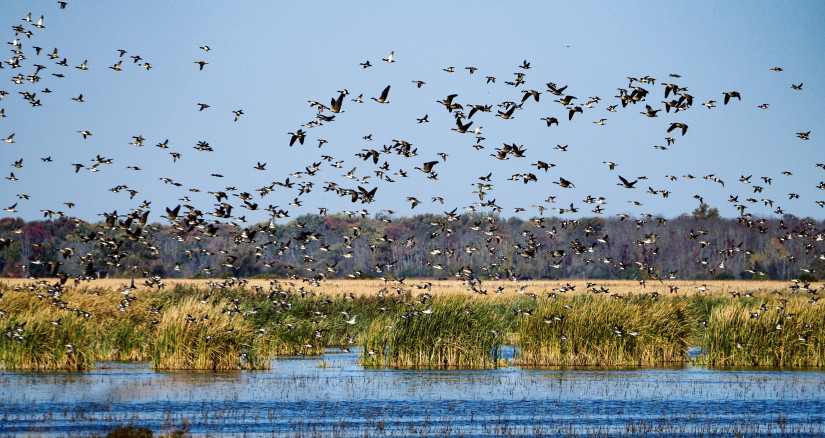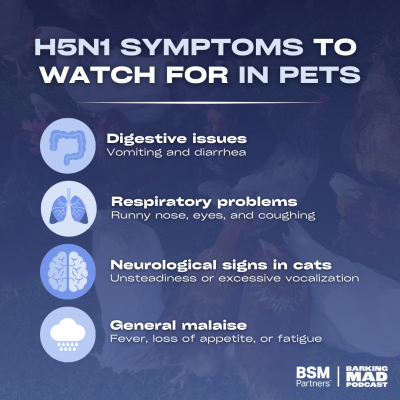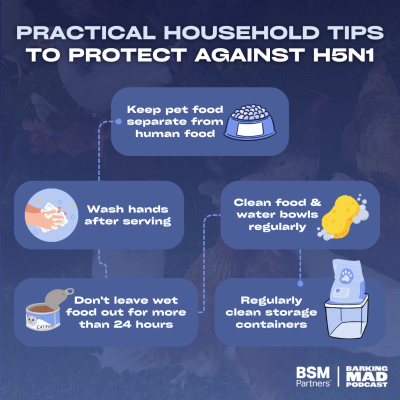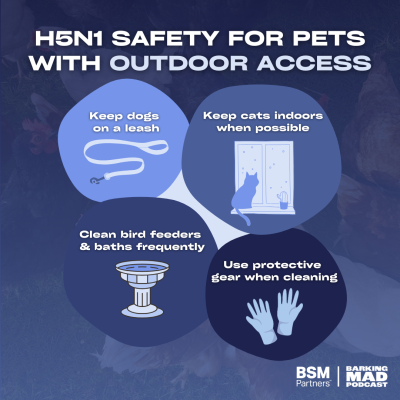
Paws for Concern: Expert Insights for Pet Parents on H5N1 Avian Influenza
The recent spread of H5N1 avian influenza has ruffled more than just feathers, raising concerns among pet parents about the safety of their animals and the food they eat. To help separate fact from fiction, BSM Partners recently hosted a free webinar to give pet owners the scoop on this virus, the real risks, and practical steps consumers can take to protect their furry companions.
The webinar featured two veterinary experts and one food safety veteran from the BSM Partners team and was supported by the World Pet Association (WPA) and Mud Bay, a leading independent pet retailer in the Pacific Northwest.
Here's what our expert panel had to say about the current H5N1 outbreak and what it means for pet-owning households across the United States.
Bird Flu 101
H5N1 is a highly pathogenic influenza Type A virus that primarily affects wild birds and poultry flocks. Type A influenza viruses are the only known category to cause flu pandemics, according to the Centers for Disease Control and Prevention (CDC).
"It is widespread in wild waterfowl, which makes it very difficult to control the spread,” explained Dr. Katy Miller, DVM, CVFT, CVNAN, CPFFCP, PCQI, PAS, Director of Veterinary Services at BSM Partners, in the opening minutes of the webinar.
One of the most important clarifications from our expert panel was about H5N1 transmission routes. The primary ways pets become infected include:
- Direct contact with infected wild birds – especially concerning for outdoor cats and hunting dogs
- Environmental exposure – through contaminated bird baths, feeders, and backyard poultry areas
- Consumption of raw, unpasteurized products – though this risk is significantly lower than direct contact
While primarily a bird disease, H5N1 has recently made headlines for its spread to mammals, including dairy cattle and domestic cats. And while the risk of a person or pet contracting the virus through a contaminated pet food product remains low, several recent recalls have highlighted a need for concerted food safety efforts among manufacturers and education for worried pet parents.

Chew on This: Pet Food Safety Facts
One of the most reassuring messages from the webinar came from Dr. Bradley Quest, DVM, Principal of Veterinary Services at BSM Partners, regarding the inherent safety of most commercial pet food products.
"Products that we know aren't going to be affected or aren't going to be at much risk, if at all, are anything that's going to be cooked and heated to any temperature greater than 165 degrees Fahrenheit,” he explained.
Fortunately, most commercial pet foods go through processing methods that bring the product to this recommended temperature to effectively eliminate the H5N1 virus. This includes kibble, canned food, and most baked food or treats.
For products that do not undergo high-heat processing (like gently cooked or raw diets), alternative processes are available, including high-pressure pasteurization, acidification, radiation, or a combination thereof.
“It's always really important to understand how a specific brand or a specific product is doing what they need to do… to ensure that risk is mitigated, again, if it’s not something that’s standard cooked, whether it’s a kibble, canned or pouch food, or a baked product,” Dr. Quest added.
Trust, But Verify: Questions for Your Pet Food Brand
For pet parents feeding alternative formats, especially those in the raw food category, our experts recommended asking manufacturers these pointed questions:
- What specific steps are you taking to mitigate H5N1 risk?
- Where are your ingredients sourced from, and are your poultry ingredients USDA-inspected?
- What processing methods do you use to ensure food safety?
- Do you undergo third-party food safety audits?
- What are your Good Manufacturing Practices (GMPs)?
 From Store to Bowl: Safe Food Handling at Home
From Store to Bowl: Safe Food Handling at Home
Later in the webinar, August Konie, MS, MBA, Principal of BSM Assurance, shared several practical tips that every pet parent can implement at home.
"These practices are good for both our regular table food as well as our pets' food,” Konie said.
Outdoor Pet Protection
For pets who spend time outdoors, Dr. Miller offered these valuable recommendations:
- Keep dogs on leashes when outside to prevent contact with wild birds
- Limit cats' outdoor access when possible
- Clean bird feeders and baths frequently using gloves and disinfectants
- Minimize pets' exposure to areas where wild birds congregate
- Practice proper hand washing after handling pet waste
"You want to make sure that not only are you minimizing the contact with wild birds, but you can also be mindful of the things that you have outside that may attract wild birds," she advised.
When to Worry: Signs to Watch For
While H5N1 infection in pets remains rare, Dr. Miller advised pet owners to be alert for potential symptoms, which can include:
- Digestive issues: Vomiting and diarrhea
- Respiratory problems: Runny nose, eyes, and coughing
- Neurological signs: Especially in cats, such as unsteadiness or excessive vocalization
- General malaise: Fever, loss of appetite, or fatigue
If your pet shows these symptoms, especially if they fall into higher-risk categories—outdoor pets, hunting dogs, pets who live near farms—contact your veterinarian immediately.
The Bottom Line: Expert Takeaways
While H5N1 is undoubtedly a serious concern for bird populations and certain high-risk individuals who work directly with infected animals, the risk to average pets and their owners remains relatively low. By practicing good hygiene, safe food handling, and being mindful of your pets' outdoor activities, you can significantly reduce any potential risks while maintaining your pets' health and wellbeing.
As this outbreak evolves, staying informed through reliable sources and maintaining open communication with veterinarians and pet food manufacturers remains the best approach for protecting our beloved companions. After all, knowledge is your best defense in keeping both your pets and your family safe.
Follow us on LinkedIn for the latest updates on all things happening here at BSM Partners.
About the Author
Jordan Tyler is the Director of Media at BSM Partners. She has more than five years of experience reporting on trends, best practices and developments in the North American pet nutrition industry. Jordan resides in Bentonville, Arkansas, with her husband and their four furry family members.
This content is the property of BSM Partners. Reproduction or retransmission or repurposing of any portion of this content is expressly prohibited without the approval of BSM Partners and is governed by the terms and conditions explained here.